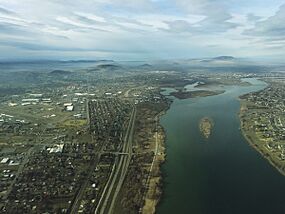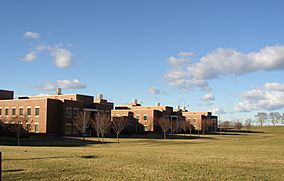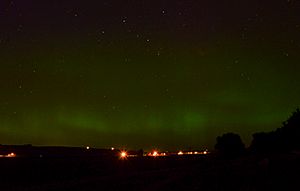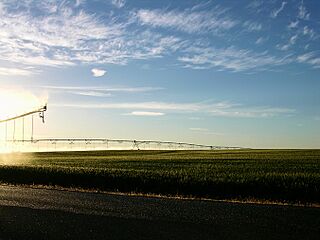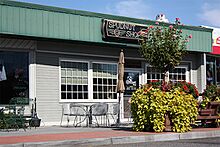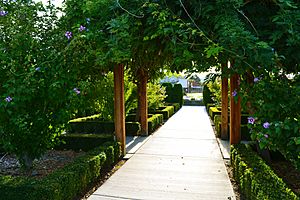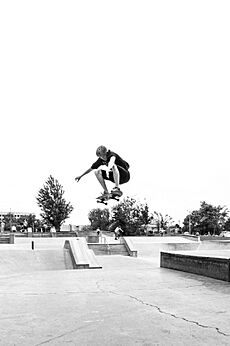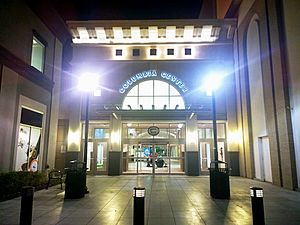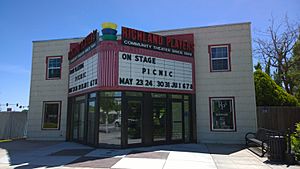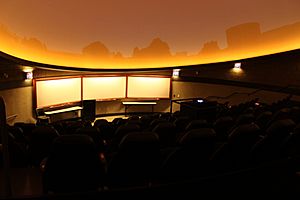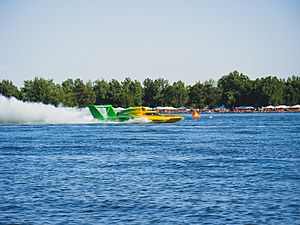Tri-Cities, Washington facts for kids
Quick facts for kids
Tri-Cities
|
|
|---|---|
| Nickname(s):
Wine Country, Atomic Town
|
|
| Country | |
| State | |
| Counties | Benton Franklin |
| Settled | 1891 |
| Area | |
| • City | 108.96 sq mi (282.2 km2) |
| Elevation | 550 ft (170 m) |
| Population
(2023)
|
|
| • City | 244,036 |
| • Urban | 255,401 (US: 157st) |
| • Metro | 314,253 (US: 166th) |
| • CSA | 375,821 (US: 106th) |
| Time zone | UTC-8 (PST) |
| • Summer (DST) | UTC-7 (PDT) |
| ZIP code |
99301, 99302, 99323, 99336, 99337, 99338, 99352, 99353, 99354
|
| Area code(s) | Area code 509 |
The Tri-Cities are three cities that are very close together in Washington. These cities are Kennewick, Pasco, and Richland. They are located where the Yakima, Snake, and Columbia Rivers meet.
The Tri-Cities are in the Columbia Basin of Eastern Washington. The cities are so close that they often feel like one big city. They form the center of the Tri-Cities metropolitan area, which includes Benton and Franklin counties. The wider urban area also includes West Richland and other smaller communities.
In 2023, the population of the Tri-Cities metropolitan area was about 314,253 people. This is a big increase from 2010. The main three cities had a combined population of 228,482 in 2023.
The Tri-Cities Airport is in Pasco. It offers flights for both people and cargo. Pasco is the main city for Franklin County, while Kennewick and Richland are in Benton County. In 2010, Kiplinger magazine said the Tri-Cities was one of the top 10 best places to raise a family. CNN/Money also ranked it as a great place for housing value. This is because the economy has been quite stable since the early 2000s.
Contents
History of the Tri-Cities Area
How the Cities Started
Pasco was the first of the Tri-Cities to become an official city in 1891. Kennewick became a city in 1904, and Richland followed in 1910. West Richland is a smaller city next to Richland. It was started by people from Richland who wanted to own their homes instead of renting from the government. This happened after the Hanford project began. West Richland became its own city in 1955.
Early Days and Farming
In the beginning, Pasco was the biggest city in the Tri-Cities. This was mainly because of its important railroad station. Pasco also had a lot of land that was easy to water for farming. Farming was the main way people made a living in the early years. The area was mostly rural until the 1940s. Even today, farming is a very important part of the Tri-Cities, especially in Pasco.
Growth from the 1940s to 1970s
In 1943, the Hanford Site was built as part of the Manhattan Project. This project was a secret effort to develop new technologies. Because of Hanford, Richland quickly became the largest city. Richland's Columbia High School even chose "Bombers" as its mascot.
The economy kept growing, but it had its ups and downs. When funding for Hanford decreased, many people lost their jobs. Other businesses slowly came to the area, but they also sometimes had to cut jobs. Since the 1970s, Kennewick has had the largest population of the three cities. The Columbia Center Mall opened in 1969 in Kennewick. This helped bring more growth to western Kennewick and south Richland.
Changes in the 1980s and 1990s
The Interstate 182 Bridge was finished in 1984. This made Pasco much easier to reach and helped the city grow. After the Cold War ended, many people worried that Hanford would close. They feared the Tri-Cities would become a ghost town. However, the United States Department of Energy changed Hanford's purpose. Instead of making materials for weapons, it focused on cleaning up and storing radioactive waste.
In the 1990s, several big companies came to the Tri-Cities. This helped the economy become more diverse, so it wasn't just about Hanford. In 1995, a new high school, Southridge High, opened in Kennewick.
The 2000s and Today
The 2000s brought fast growth as Hanford hired many workers for cleanup. Also, many retired people moved to the Tri-Cities from other parts of the Northwest. During this time, all three cities grew a lot. Pasco became the fastest-growing city in Washington. In 2005, Pasco's population passed Richland's for the first time since before Hanford. A new high school, Chiawana High School, was built. By 2019, it was the largest high school in the state.
Even during the economic recession in the late 2000s, the Tri-Cities kept growing. Its economy stayed stable partly because of government funding for the Hanford cleanup efforts.
Climate and Geography
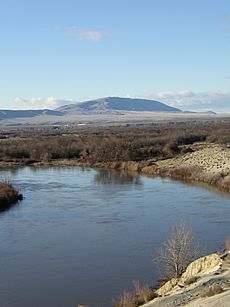
The Tri-Cities has a semi-arid climate, which means it's quite dry. It gets only about 5 to 7 inches (127 to 178 mm) of rain each year. Strong winds, sometimes over 30 mph (48 km/h), can blow through the area.
The region has about 225 clear days each year, mostly from April to November. Temperatures can go from as low as -10°F (-23°C) in winter to as high as 110°F (43°C) in summer. The record low was -29°F (-34°C) in 1919, and Richland reached 118°F (48°C) in 2021. The area gets about 7 inches (18 cm) of snow each year, but it has received up to 50 inches (127 cm) in the past. Because it's so dry and sandy, dust from the wind can be a bit annoying for residents. However, the nearby rivers provide plenty of water for irrigation.
Washington is in the Pacific Standard Time Zone. The Tri-Cities is the largest metropolitan area in southeastern Washington. The big Cascade Mountain Range to the west makes the climate dry. This is because the mountains block rain from reaching the eastern side of the state. This effect is called a rain shadow. The climate here creates a shrub-steppe ecosystem. This unique environment has 18 types of plants that grow only in this region. The Fitzner/Eberhardt Arid Lands Ecology Reserve was set up to study these special plants and animals. It's the largest area of shrub-steppe ecosystem left in Washington.
| Climate data for Tri-Cities, Washington (Tri-Cities Airport), 1991–2020 normals, extremes 1894–present | |||||||||||||
|---|---|---|---|---|---|---|---|---|---|---|---|---|---|
| Month | Jan | Feb | Mar | Apr | May | Jun | Jul | Aug | Sep | Oct | Nov | Dec | Year |
| Record high °F (°C) | 74 (23) |
74 (23) |
87 (31) |
95 (35) |
104 (40) |
115 (46) |
115 (46) |
115 (46) |
102 (39) |
90 (32) |
78 (26) |
71 (22) |
115 (46) |
| Mean maximum °F (°C) | 58.9 (14.9) |
61.9 (16.6) |
71.8 (22.1) |
82.6 (28.1) |
92.4 (33.6) |
98.9 (37.2) |
104.7 (40.4) |
102.5 (39.2) |
93.5 (34.2) |
80.8 (27.1) |
67.8 (19.9) |
59.3 (15.2) |
105.7 (40.9) |
| Mean daily maximum °F (°C) | 41.4 (5.2) |
48.6 (9.2) |
58.6 (14.8) |
67.0 (19.4) |
76.5 (24.7) |
83.1 (28.4) |
92.5 (33.6) |
90.7 (32.6) |
80.9 (27.2) |
65.8 (18.8) |
49.9 (9.9) |
41.0 (5.0) |
66.3 (19.1) |
| Daily mean °F (°C) | 34.6 (1.4) |
38.4 (3.6) |
45.8 (7.7) |
52.7 (11.5) |
61.4 (16.3) |
67.8 (19.9) |
74.7 (23.7) |
73.2 (22.9) |
64.2 (17.9) |
52.1 (11.2) |
40.9 (4.9) |
34.1 (1.2) |
53.3 (11.9) |
| Mean daily minimum °F (°C) | 27.8 (−2.3) |
28.2 (−2.1) |
33.1 (0.6) |
38.4 (3.6) |
46.3 (7.9) |
52.6 (11.4) |
56.9 (13.8) |
55.7 (13.2) |
47.6 (8.7) |
38.4 (3.6) |
31.9 (−0.1) |
27.3 (−2.6) |
40.4 (4.6) |
| Mean minimum °F (°C) | 11.7 (−11.3) |
14.6 (−9.7) |
21.4 (−5.9) |
27.8 (−2.3) |
34.1 (1.2) |
43.0 (6.1) |
48.4 (9.1) |
47.0 (8.3) |
37.1 (2.8) |
24.7 (−4.1) |
17.8 (−7.9) |
12.0 (−11.1) |
4.1 (−15.5) |
| Record low °F (°C) | −27 (−33) |
−23 (−31) |
−1 (−18) |
18 (−8) |
26 (−3) |
35 (2) |
38 (3) |
37 (3) |
21 (−6) |
9 (−13) |
−8 (−22) |
−29 (−34) |
−29 (−34) |
| Average precipitation inches (mm) | 1.03 (26) |
0.63 (16) |
0.69 (18) |
0.66 (17) |
0.71 (18) |
0.61 (15) |
0.15 (3.8) |
0.27 (6.9) |
0.31 (7.9) |
0.66 (17) |
0.87 (22) |
1.03 (26) |
7.62 (193.6) |
| Average snowfall inches (cm) | 4.0 (10) |
1.9 (4.8) |
0.1 (0.25) |
0.0 (0.0) |
0.0 (0.0) |
0.0 (0.0) |
0.0 (0.0) |
0.0 (0.0) |
0.0 (0.0) |
0.0 (0.0) |
0.9 (2.3) |
2.5 (6.4) |
9.4 (23.75) |
| Average precipitation days (≥ 0.01 in) | 10.0 | 7.8 | 7.6 | 6.7 | 7.2 | 5.0 | 1.8 | 2.1 | 3.0 | 6.3 | 9.0 | 10.3 | 76.8 |
| Average snowy days (≥ 0.1 in) | 2.5 | 1.1 | 0.1 | 0.0 | 0.0 | 0.0 | 0.0 | 0.0 | 0.0 | 0.0 | 0.5 | 1.6 | 5.8 |
| Source 1: NOAA | |||||||||||||
| Source 2: National Weather Service (snow/snow days 1894–2019) | |||||||||||||
| Climate data for Kennewick, Washington, 1991–2020 normals, extremes 1894–present | |||||||||||||
|---|---|---|---|---|---|---|---|---|---|---|---|---|---|
| Month | Jan | Feb | Mar | Apr | May | Jun | Jul | Aug | Sep | Oct | Nov | Dec | Year |
| Record high °F (°C) | 74 (23) |
74 (23) |
87 (31) |
95 (35) |
104 (40) |
114 (46) |
115 (46) |
115 (46) |
100 (38) |
89 (32) |
79 (26) |
72 (22) |
115 (46) |
| Mean maximum °F (°C) | 59.5 (15.3) |
61.8 (16.6) |
70.8 (21.6) |
81.5 (27.5) |
91.4 (33.0) |
97.9 (36.6) |
103.4 (39.7) |
102.1 (38.9) |
92.9 (33.8) |
80.1 (26.7) |
68.1 (20.1) |
59.8 (15.4) |
104.4 (40.2) |
| Mean daily maximum °F (°C) | 41.7 (5.4) |
48.1 (8.9) |
58.1 (14.5) |
66.3 (19.1) |
75.3 (24.1) |
82.0 (27.8) |
91.3 (32.9) |
90.3 (32.4) |
80.5 (26.9) |
65.9 (18.8) |
50.9 (10.5) |
41.5 (5.3) |
66.0 (18.9) |
| Daily mean °F (°C) | 35.5 (1.9) |
39.5 (4.2) |
47.0 (8.3) |
54.3 (12.4) |
62.7 (17.1) |
69.2 (20.7) |
76.8 (24.9) |
75.8 (24.3) |
66.8 (19.3) |
54.5 (12.5) |
42.9 (6.1) |
35.6 (2.0) |
55.1 (12.8) |
| Mean daily minimum °F (°C) | 29.6 (−1.3) |
31.0 (−0.6) |
36.2 (2.3) |
42.5 (5.8) |
50.4 (10.2) |
56.7 (13.7) |
62.7 (17.1) |
61.6 (16.4) |
53.5 (11.9) |
43.4 (6.3) |
35.2 (1.8) |
30.0 (−1.1) |
44.4 (6.9) |
| Mean minimum °F (°C) | 15.3 (−9.3) |
18.8 (−7.3) |
26.1 (−3.3) |
33.5 (0.8) |
40.1 (4.5) |
48.4 (9.1) |
54.5 (12.5) |
53.3 (11.8) |
43.8 (6.6) |
30.7 (−0.7) |
22.5 (−5.3) |
16.8 (−8.4) |
10.0 (−12.2) |
| Record low °F (°C) | −27 (−33) |
−23 (−31) |
8 (−13) |
18 (−8) |
26 (−3) |
35 (2) |
38 (3) |
37 (3) |
21 (−6) |
14 (−10) |
−8 (−22) |
−29 (−34) |
−29 (−34) |
| Average precipitation inches (mm) | 1.13 (29) |
0.79 (20) |
0.66 (17) |
0.61 (15) |
0.81 (21) |
0.59 (15) |
0.20 (5.1) |
0.17 (4.3) |
0.26 (6.6) |
0.66 (17) |
0.86 (22) |
1.13 (29) |
7.87 (201) |
| Average snowfall inches (cm) | 1.3 (3.3) |
0.1 (0.25) |
0.0 (0.0) |
0.0 (0.0) |
0.0 (0.0) |
0.0 (0.0) |
0.0 (0.0) |
0.0 (0.0) |
0.0 (0.0) |
0.0 (0.0) |
0.4 (1.0) |
0.4 (1.0) |
2.2 (5.55) |
| Average precipitation days (≥ 0.01 in) | 11.1 | 8.1 | 7.8 | 6.9 | 6.3 | 4.7 | 2.1 | 1.9 | 2.6 | 6.3 | 8.9 | 10.5 | 77.2 |
| Average snowy days (≥ 0.1 in) | 0.8 | 0.1 | 0.0 | 0.0 | 0.0 | 0.0 | 0.0 | 0.0 | 0.0 | 0.0 | 0.3 | 0.6 | 1.8 |
| Source 1: NOAA | |||||||||||||
| Source 2: National Weather Service | |||||||||||||
| Climate data for Richland, Washington, 1991–2020 normals, extremes 1944–present | |||||||||||||
|---|---|---|---|---|---|---|---|---|---|---|---|---|---|
| Month | Jan | Feb | Mar | Apr | May | Jun | Jul | Aug | Sep | Oct | Nov | Dec | Year |
| Record high °F (°C) | 71 (22) |
73 (23) |
82 (28) |
92 (33) |
105 (41) |
112 (44) |
113 (45) |
113 (45) |
106 (41) |
93 (34) |
78 (26) |
69 (21) |
113 (45) |
| Mean maximum °F (°C) | 57.6 (14.2) |
60.4 (15.8) |
70.0 (21.1) |
79.9 (26.6) |
89.3 (31.8) |
95.2 (35.1) |
101.5 (38.6) |
99.9 (37.7) |
91.5 (33.1) |
78.6 (25.9) |
66.0 (18.9) |
58.2 (14.6) |
102.4 (39.1) |
| Mean daily maximum °F (°C) | 40.6 (4.8) |
47.5 (8.6) |
57.1 (13.9) |
65.1 (18.4) |
73.9 (23.3) |
80.2 (26.8) |
89.3 (31.8) |
88.1 (31.2) |
78.9 (26.1) |
64.3 (17.9) |
49.0 (9.4) |
39.9 (4.4) |
64.5 (18.1) |
| Daily mean °F (°C) | 34.7 (1.5) |
38.8 (3.8) |
46.1 (7.8) |
53.0 (11.7) |
61.1 (16.2) |
67.3 (19.6) |
74.7 (23.7) |
73.6 (23.1) |
65.2 (18.4) |
53.0 (11.7) |
41.3 (5.2) |
34.1 (1.2) |
53.6 (12.0) |
| Mean daily minimum °F (°C) | 28.8 (−1.8) |
30.1 (−1.1) |
35.1 (1.7) |
41.0 (5.0) |
48.3 (9.1) |
54.4 (12.4) |
60.0 (15.6) |
59.0 (15.0) |
51.4 (10.8) |
41.7 (5.4) |
33.6 (0.9) |
28.4 (−2.0) |
42.7 (5.9) |
| Mean minimum °F (°C) | 13.0 (−10.6) |
16.8 (−8.4) |
24.3 (−4.3) |
30.7 (−0.7) |
37.5 (3.1) |
46.1 (7.8) |
52.0 (11.1) |
50.7 (10.4) |
40.9 (4.9) |
28.3 (−2.1) |
19.9 (−6.7) |
14.6 (−9.7) |
7.9 (−13.4) |
| Record low °F (°C) | −21 (−29) |
−22 (−30) |
7 (−14) |
23 (−5) |
30 (−1) |
38 (3) |
41 (5) |
39 (4) |
31 (−1) |
13 (−11) |
−6 (−21) |
−10 (−23) |
−22 (−30) |
| Average precipitation inches (mm) | 1.04 (26) |
0.67 (17) |
0.64 (16) |
0.62 (16) |
0.63 (16) |
0.56 (14) |
0.23 (5.8) |
0.13 (3.3) |
0.29 (7.4) |
0.54 (14) |
0.87 (22) |
1.07 (27) |
7.29 (184.5) |
| Average snowfall inches (cm) | 1.9 (4.8) |
1.9 (4.8) |
0.2 (0.51) |
0.0 (0.0) |
0.0 (0.0) |
0.0 (0.0) |
0.0 (0.0) |
0.0 (0.0) |
0.0 (0.0) |
trace | 0.1 (0.25) |
2.3 (5.8) |
6.4 (16.16) |
| Average precipitation days (≥ 0.01 in) | 11.8 | 8.7 | 8.1 | 7.1 | 7.1 | 4.7 | 2.2 | 2.1 | 3.1 | 6.7 | 10.3 | 11.9 | 83.8 |
| Average snowy days (≥ 0.1 in) | 1.5 | 0.9 | 0.3 | 0.0 | 0.0 | 0.0 | 0.0 | 0.0 | 0.0 | 0.0 | 0.4 | 1.9 | 5.0 |
| Source 1: NOAA (snow/snow days 1981–2010) | |||||||||||||
| Source 2: National Weather Service | |||||||||||||
The Tri-Cities area has limited city lights. This means it's a great place for looking at stars and planets with your eyes or a telescope. The Tri-City Astronomy Club often holds events to watch the stars at the Hanford Observatory.
Hiking spots like Badger Mountain, Candy Mountain, and Jump Off Joe Butte offer amazing views. You can see sunrises and sunsets, and even study the stars. Sometimes, the aurora borealis (also known as the northern lights) can be seen near the Tri-Cities.
Learning and Schools
Colleges and Universities
The Tri-Cities area has several places for higher education:
- Washington State University Tri-Cities: This is a four-year campus of Washington State University in Richland. About 2,000 students attend here.
- Columbia Basin College: This is a two-year college that also offers a four-year degree in Applied Management. It has about 8,000 students. The main campus is in Pasco, with a branch and nursing school in Richland.
- Tri-Tech Skills Center: This is a smaller vocational school in Kennewick. It's run by the Kennewick School District. Students from Pasco and Richland school districts can also apply.
- Charter College: Located in Pasco, it offers programs in technical and medical fields.
In 2005, the Washington State University campus in Richland became a four-year school. It welcomed its first undergraduate students in 2007. The campus focuses on biotechnology, computer science, and engineering. This is because of the nearby Pacific Northwest National Laboratory and Hanford Site. It also offers many other subjects like English and history.
Columbia Basin College also provides college courses for people in the Tri-Cities. It serves students from areas like Mattawa, Washington and Umatilla, Oregon.
Schools for Kids and Teens
Each city has its own school district: Kennewick, Pasco, and Richland.
Public high schools in Kennewick include Kennewick High School, Kamiakin High School, and Southridge High School. In the Pasco School District, you'll find Pasco High School, Chiawana High School, and New Horizons High School. Richland School District has Richland High School, Hanford High School, and River's Edge High School.
There are also two special high schools for the whole Tri-Cities area:
- Tri-Tech: This is a technical high school in Kennewick. Students from all over the Tri-Cities can attend.
- Delta High: This school in Pasco focuses on science and technology. It's supported by the school districts of Pasco, Kennewick, and Richland, along with other organizations.
The area also has several private schools. These include Tri-Cities Prep Highschool and Liberty Christian School.
Local Industries
The Hanford Site's Past
In the 1940s, the Hanford site employed most of the people living here. The United States government built a top-secret facility there. Its purpose was to produce materials for nuclear weapons. The government built temporary homes for over 45,000 workers. Permanent homes were built in Richland for other staff. Richland's population grew very quickly. Most people didn't know what Hanford was for until 1945. After World War II, Hanford continued to produce materials for nuclear weapons during the Cold War. After 1991, Hanford's mission changed. It became focused on cleaning up and safely storing radioactive waste.
Hanford's Modern Role
The Hanford site is now one of the largest cleanup projects in the United States. It costs over $1.4 million each day to turn nuclear waste into glass. This process is called vitrification. Vitrification is a proven way to dispose of and store nuclear waste safely for a long time.
Cleaning up the waste was first estimated to cost $2.8 billion over five years. By the early 1990s, estimates grew to $50 billion over 30 years. As of 2021, the cleanup is projected to cost between $300 and $640 billion. It is expected to be finished around 2078. Over 18% of all jobs in the Benton Franklin County area are related to nuclear work, research, or engineering.
Columbia Generating Station
The Columbia Generating Station is a nuclear power plant located ten miles outside of Richland. It is the only nuclear power station in the Pacific Northwest. The plant can produce 1,190 megawatts of electricity. This is enough to power a city the size of Seattle. It provides about 10% of Washington's electricity. The plant has many safety features to protect against natural disasters or other threats.
Farming and Agriculture
The Tri-Cities' economy has always relied on farming and the Hanford Nuclear Reservation. Since Pasco became a city in 1891, the Tri-Cities has had a lot of farming. This is thanks to the three nearby rivers that provide water for irrigation.
Wheat is the most common crop grown here. However, large amounts of apples, corn, and grapes are also grown. Other products include potatoes and asparagus. Cherries are also grown in the region.
The grapes grown in the region are very important for the wine industry. Wineries attract many tourists to the area. With 160 wineries in the Columbia Valley, this industry brings in $1 billion each year in Benton County alone.
The Tri-Cities' climate helps support a strong farming economy. Local farms and businesses provide jobs for thousands of people. Some top employers in agriculture include ConAgra and Tyson Foods. Farming makes up 9.5% of jobs in the Tri-Cities. In 2012, Washington was ranked number one in the U.S. for growing apples, hops, sweet cherries, and other crops. The Mid-Columbia region, including the Tri-Cities, grows most of these crops. The climate and river irrigation allow farmers to grow corn, hay, wheat, and potatoes. There are many farms in Benton and Franklin counties.
Local Food Scene
The Tri-Cities has many local restaurants. The Spudnut Shop in Richland opened in 1948 and is still family-run. The Travel Channel even featured their donuts, which are "made from potato flour and then deep-fried to perfection."
Another notable place is Porter's BBQ restaurant. It started as a food truck in Richland and was featured on the TV show Diners, Drive-Ins and Dives.
Wine and Breweries
The Columbia Valley has long, warm summer days and cool nights. This dry weather, along with rich volcanic soils and controlled irrigation, creates perfect conditions for growing wine grapes.
Many types of grapes are grown here, including Chardonnay, Cabernet Sauvignon, and Merlot.
The Tri-Cities area has a rich winery culture that attracts tourists. Some local microbreweries include Ice Harbor Brewery Company and Atomic Ale Brewpub and Eatery. Ice Harbor Brewery was founded in 1996 and has two locations. In 2010, Ice Harbor won awards for its beers. Atomic Ale Brew Pub & Eatery in Richland is the oldest brewpub in the Tri-Cities, opened in 1997.
Farmers Markets
The Market at the Parkway in Richland is a farmers market. It happens every Friday from June to October. You can find fresh produce, special foods, and crafts from local artists.
The Pasco Farmers Market has been around for over 25 years. It takes place every Wednesday and Saturday morning from May to October. It mainly sells fresh produce.
There is also a farmers market in Kennewick. It's held on Thursday evenings from late May to October.
Things to Do and See
Outdoor Fun
The Tri-Cities has a dry climate, hot summers, and mild winters. This makes it great for many outdoor activities.
Golf Courses
The area has 10 golf courses that can be played almost all year. These include Canyon Lakes in Kennewick, Sun Willows in Pasco, and Columbia Point in Richland.
Running Trails and Events
The Tri-Cities has many outdoor trails for running. Several running events are held throughout the year, often sponsored by the Three Rivers Road Runners Club.
- Columbia River Classic: Started in 1975, it's the oldest "fun run" here. It has a 10-mile and a 2-mile race.
- Tri-Cities Marathon: Started in 1980, this race goes through Richland, Pasco, and Kennewick along the Columbia River.
- St. Paddy's Foot Race and Leprechaun Dash: This annual event includes a 1-mile dash for elementary and middle school students, plus 5K and 10K races.
Paved Trails for Walking and Biking
The Tri-Cities is connected by 67 miles (108 km) of paved trails for walking and biking. The 23-mile (37 km) Sacagawea Heritage Trail forms a loop. It crosses two bridges and follows the Columbia River through Kennewick and Pasco. This trail also connects to the Richland Riverfront Trail. This trail highlights Washington's role in the history of nuclear energy.
Water Sports
The Yakima, Snake, and Columbia rivers meet here. This provides many chances for boating, fishing, and swimming. You can find free boat launches in all the cities.
Parks and Playgrounds
The Tri-Cities has seven parks along the river, plus many other parks and playgrounds. There are three skate parks in the area: two in Kennewick and one in Richland.
Highlands Grange Park in Kennewick is a large public park. It covers 26 acres (11 ha) and serves many nearby communities.
The park has a playground, basketball courts, a soccer/softball field, tennis courts, and a roller hockey rink. It also has a water feature and a walking path through a beautiful garden.
There are picnic shelters for events and plenty of parking.
The park's best features are its demonstration garden and water play area. The water feature is fun for kids in the summer. The demonstration garden is a main attraction, with many roses and other flowers cared for by expert gardeners. This park is often used for public events like weddings and BBQs.
Skateboarding Parks
The Tri-Cities has three skate parks. Jeanette Taylor Park in Kennewick is ranked as the third-best skate park in Washington. It was finished in 2005 and covers 22,100 square feet (2,053 m²). It has street elements, a large bowl, and a half-pipe. The Jeanette Taylor skate park hosts many contests and events.
Richland Skatepark was designed by Wormhoudt Inc and built by Grindline Skateparks. This park has a big bowl, a medium bowl, a flow section, a mini ramp, ledges, rails, and stairs.
Sports Teams
The Tri-Cities is home to two professional sports teams:
- Tri-City Dust Devils: This is a minor league baseball team. They are part of the Northwest League and are connected to the Los Angeles Angels. The Dust Devils came to the Tri-Cities in 2001. They play at Gesa Stadium.
- Tri-City Americans: This is a major junior ice hockey team. They are part of the Western Hockey League. The Americans moved to the Tri-Cities in 1988. They play at the Toyota Center in Kennewick.
From 2005 to 2016, the Tri-Cities also had an indoor football team called the Tri-Cities Fever.
Shopping and Entertainment
The Columbia Center Mall in Kennewick is a large shopping center. It is the biggest regional mall in Southeastern Washington.
Theater and Arts
The Richland Players Theater has been putting on live shows for over 70 years. It started in 1944 to bring music, comedy, and culture to the community. Today, over 7,500 people attend shows each year. The theater also helps local retirees and people with visual or hearing impairments enjoy the performances.
The Bechtel National Planetarium is at Columbia Basin College in Pasco. It has a 36-foot (11 m) dome that gives a 180° view. It is the largest digital theater in Washington state and can seat the most people.
The Toyota Center in Kennewick opened in 1988. It's a large arena used for many things. It hosts touring Broadway shows, concerts, conventions, and special events.
Annual Events
Many events happen in the Tri-Cities throughout the year:
- Cool Desert Nights: A classic car show held in Richland in June. It attracts visitors from all over the Northwest.
- Tri-Cities Water Follies: An annual event in July with hydroplane boat racing and air shows. This includes the Columbia Cup. In 2019, it was its 54th year. It brings in over 7,000 tourists and $3 million in visitor spending. The main event is the Apollo Columbia Cup, one of six Unlimited Hydroplane races. These boats skim across the water at speeds up to 220 mph (354 km/h). Visitors can even go into the pit area to see the boats up close.
- Allied Arts Show: An annual art show held in Richland's Howard Amon Park in July.
- Benton/Franklin Fair: An annual regional fair held at the Kennewick fairgrounds in late August.
- Hogs and Dogs: An annual car and motorcycle rally in West Richland. It's one of the largest motorcycle rallies in the Northwest.
- Ye Merrie Greenwood Faire: An annual renaissance fair held along the Columbia River. It features historical costumes and vendors.
- Savor the Flavor: In November, Food Network Stars, wines, and local restaurants come together for this two-day food and drink event in Pasco.
- Radcon: A science fiction and fantasy convention held every February in Pasco. It's the second-largest of its kind in the Pacific Northwest.
- The Three Rivers Convention Center in Kennewick hosts many events throughout the year.
- Pasco Flea Market: Located in Pasco, this market is open from March to December. It has about 350 different vendors. On a single Sunday, it can have between 3,000 and 5,000 visitors.
- Fall Dog Show: Hosted by the Richland Kennel Club, usually held in Columbia Park in Kennewick in late September or early October.
How the Tri-Cities Has Grown
Historical combined population of Kennewick, Pasco, and Richland.
| Historical population | |||
|---|---|---|---|
| Census | Pop. | %± | |
| 1910 | 3,652 | — | |
| 1920 | 5,325 | 45.8% | |
| 1930 | 5,223 | −1.9% | |
| 1940 | 6,078 | 16.4% | |
| 1950 | 42,143 | 593.4% | |
| 1960 | 52,314 | 24.1% | |
| 1970 | 55,422 | 5.9% | |
| 1980 | 86,403 | 55.9% | |
| 1990 | 94,807 | 9.7% | |
| 2000 | 125,467 | 32.3% | |
| 2010 | 181,756 | 44.9% | |
| 2020 | 220,959 | 21.6% | |
If the three cities were combined into one, it would be the 100th largest city by population in the United States. It would also be the 73rd largest by land area.
Kennewick's Population
As of April 1, 2024, Kennewick's population was estimated to be 87,120.
In 2023, there were 85,155 people living in Kennewick. About 37.6% of households had children under 18. The average household had 2.8 people. About 36% of the population was Hispanic or Latino.
Pasco's Population
As of April 1, 2021, Pasco's population was estimated to be 78,700.
In 2020, there were 77,108 people in Pasco. About 45.6% of households had children under 18. The average household had 3.30 people. Over 56% of the population was Hispanic or Latino.
Richland's Population
As of April 1, 2021, Richland's population was estimated to be 61,320.
In 2020, there were 60,560 people in Richland. About 34.1% of households had children under 18. The average household had 2.48 people. About 4.72% of the population was Hispanic or Latino.
Richland ranks 83rd out of 522 areas in Washington for income per person. This is the highest rank in Benton County.
News and Media
Newspapers
The Tri-City Herald is a daily newspaper based in Kennewick. It serves the Tri-Cities area. tú Decides is a free newspaper printed in both Spanish and English. The Tri-Cities Area Journal of Business covers local business news.
Television
The Tri-Cities is part of the Yakima television market. This market had 230,950 TV households in 2017. Local TV stations include KFFX-TV (Fox), KVVK (Univision), KEPR (CBS), KNDU (NBC), KTNW (PBS), and KVEW (ABC).
Radio Stations
In 2018, some of the most listened-to radio stations in the Tri-Cities included:
- KEGX-FM (classic rock)
- KORD-FM (country)
- KUJ-FM (chart music)
- KIOK-FM (country)
- KXRX-FM (classic rock)
- KFLD-AM (news)
Future Plans for the Cities
Over the years, people have suggested combining the cities into one larger city. The idea is that one big city would get more attention and focus for the region. However, these proposals have not been approved.
Some suggested names for a combined area include "Quad-Cities" (to include West Richland), "Tri-Cities," or "Three Rivers." West Richland has also been suggested to change its name to "Red Mountain." This would help it stand out from Richland.
Famous People from the Tri-Cities
Artists and Writers
- Patricia Briggs: Urban fantasy author.
- Orson Scott Card: Science fiction writer.
- Chuck Palahniuk: Novelist, wrote Fight Club.
- Joseph Santos: Artist and painter.
- Ron Silliman: Poet.
- Mike Bivins: Journalist.
Business, Science, and Other Fields
- James Albaugh: Executive Vice President at The Boeing Company.
- Stephanie Dorgan: Lawyer and founder of The Crocodile nightclub.
- Jim Mattis: 26th United States Secretary of Defense.
- John Archibald Wheeler: Theoretical physicist, worked with Albert Einstein.
- Kayla Barron: NASA Astronaut.
- Don Watts: Entrepreneur and former CEO of Watts Brothers Farms.
Entertainers and Musicians
- Terence Knox: Actor, known for Tour of Duty.
- James Otto: Country singer and songwriter.
- James Wong Howe: Academy Award-winning cinematographer.
- Kevin T. O'Connor: Musician.
- Kristine W: Singer and songwriter.
- Larry Coryell: Jazz guitarist.
- Nate Mendel: Foo Fighters bassist.
- Santino Fontana: Stage actor and director.
- Sharon Tate: Actress.
- Michael Peterson: Country singer and songwriter.
Sports Stars
- Adam Carriker: Played for the Washington Redskins.
- Brian Urlacher: Chicago Bears Pro Bowl linebacker.
- Bruce Kison: Pittsburgh Pirates World Series pitcher.
- Damon Lusk: NASCAR driver.
- Gene Conley: Played both Major League Basketball and Baseball.
- Hope Solo: United States women's national soccer team goalkeeper.
- Jason Repko: Minnesota Twins outfielder.
- Jeremy Bonderman: Seattle Mariners All-Star pitcher.
- Kimo von Oelhoffen: Former Defensive Tackle for the Pittsburgh Steelers.
- Michael Jackson: Seattle Seahawks linebacker.
- Ray Mansfield: National Football League player, center for the Pittsburgh Steelers.
- Ray Washburn: Former Major League Baseball pitcher.
- Travis Buck: Oakland Athletics outfielder.
- Tyler Brayton: Played for the Carolina Panthers.
- Chad Ward: NFL offensive lineman.
- Shawn O'Malley: Major League Baseball Player.
- Greg Olson: Oakland Raiders offensive coordinator.
|
See also
 In Spanish: Tri-Cities para niños
In Spanish: Tri-Cities para niños


